Porcelain Insulator News
by Elton Gish
Reprinted from "Crown Jewels of the Wire", March 1997, page 26
Variety is never lacking when it comes to collecting porcelain insulators. I
thought surely we would have rounded up most of the remaining new unipart styles
with the collector surveys sent out to those who helped me compile the Value
Guide for Unipart and Multipart Porcelain Insulators. Eighty-six new unipart
styles were illustrated in that book which were assigned after Jack Tod's 1988
3rd edition book, Porcelain Insulator Guide Book. Would you believe that 16 new
unipart styles have been identified since the Value Guide was published in
mid-1995! Strangely, we haven't reported any new unipart styles in PIN since
November 1995. We report a few this month and start off with a super new Jumbo
style!
I wasn't able to make the London show last November. Steve and Lois Blair
(NIA #248 & #247) have a reputation for putting on one of the best shows
each year which rivals the quality of the annual NIA National Show. In many
respects it is like the shows of years gone by because the atmosphere is
relaxed, informal, and there is a lot of trading and activity going on all
weekend. Many new finds and rare insulators make their appearance for the first
time. The show last November was no exception. Many people reported to me that
there was a lot of activity with porcelain insulators of all descriptions. A
light blue Mickey Mouse (U-395) traded hands!
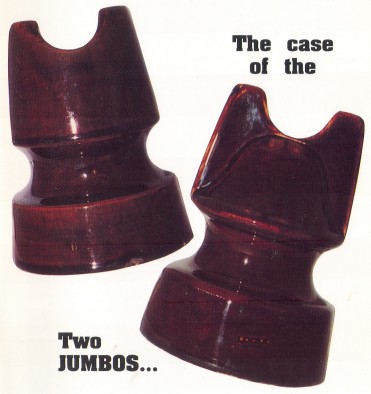
(cover photo)
Jack Snyder (NIA #241) walked in
with a very different style of U-407 Jumbo. Thanks to Marilyn and Bill Albers
(NIA #541 & #1276) for taking photographs for me and jotting down a few
selected dimensions so I could make a scale drawing (by remote control).
Normally we like to get a shadow profile, but occasionally I can make a drawing
from a photograph and dimensions if the style is not too complicated. I have
assigned this new Jumbo style U-407A and it quickly found a new home. Crown
Jewels of the Wire features a nice color photograph of U-407 and U-407A on the
cover of this month's issue to highlight the find. Here we will show the scale
drawings of the two styles so you can see how they are different. Note that the crown on U-407 A is round with straight
sides and a cable groove formed in the top rather than cut out to form
"ears" as on U-407 (something like putting ears on the dome of CD 140
to form CD 269).
The next three new unipart styles are not nearly as exciting. U-238C is one I
added to my collection last year. It has a unique glaze that is light blue with
some dark blue specs. You might recall this glaze description in CJ 5-95-14
where we discussed this glaze on U-376 with LIMA, N.Y. marking and on U-4 N-N.
This glaze might be characteristic of Lima production. Another characteristic
that is common with all three insulators (and this glaze color) is a dime-size
impression in the top of the fully-glazed pinhole. Two other insulators I have
with the same characteristics are U-243 and U-600. The U-243 specimen has a very
light blue glaze (almost gray) with lots of dark blue specs and the U-600
specimen has a darker light blue glaze with dark blue specs. Unipart insulators
with the Lima marking are very rare so we may never be able to attribute the
unmarked insulators, with this unique glaze, to Lima with any greater certainty.
You might have another style in your collection with this unusual glaze, fully
glazed pinhole, and dime-size impression. Please send a photograph and
description if you do.
 |
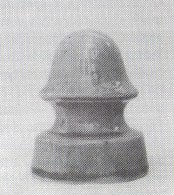
U-238C has a unique light blue glaze with dark blue specs. |
Bob Stahr (NIA #4186) has been actively collecting dry process porcelain for
a number of years. There are many unusual, unmarked dry process styles and a
very interesting collection can be put together at minimal cost with new
additions easily available at shows. I doubt that all the various styles and
colors have been reported. Bob reported a new style which has been assigned U-269B. Specimens have been found in dark metallic tan, bluish gray, and an odd
mottled very light blue with darker blue areas where the glaze is thickest. If
the glaze is not thin (on the gray and blue ones), a mold line is visible only
across the wire groove (see photo) indicating that the wire groove was not
formed by trimming. The threads are well formed and totally unglazed and the top
of the pinhole is slightly concave. This later feature alone rules out any
chance they were manufactured by Thomas. So far we cannot attribute a
manufacturer to U-269B.
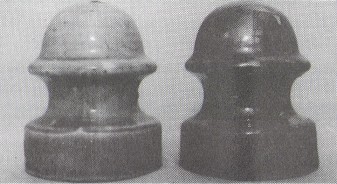
Dry process porcelain U-269B with light blue glaze (left)
and dark metallic
tan glaze (right).
Another puzzling insulator reported by Bob is the new style, U-600B. On the
unmarked specimen I have, the dry process porcelain is finely made except for a
few vertical cracks in the porcelain around the tie-wire groove. The transparent
white glaze is finely crackled all over which indicates that the glaze formula
was not properly "fitted" to the porcelain (indicative of very early
manufacture -- perhaps before 1910). The threads are fully glazed with a firing
rest on the extended skirt. We are unable to attribute a manufacturer to this
style. We know that Akron HP Porcelain Co. produced dry process pin-types from
1903-1907 (until about the time Ohio Brass took control of the company) and a
few styles with the unique teat rest feature can be attributed to that company.
We suspect that Akron could have made some of these odd dry process insulators,
but the pinhole characteristics (and glaze colors in some cases) are somewhat
different from those currently attributed to Akron. It is almost as if a
heretofore unknown company produced them.
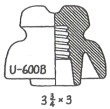 |
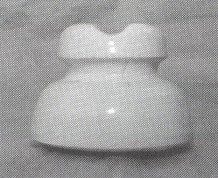 |
|
Dry process porcelain U-600B with white glaze. |
The next insulator was also reported by Bob Stahr. The insulator, U-240, was found in the
northwest and looks as though it was made by Pittsburg. It has a mold line
completely over the insulator which has been crudely trimmed flush to the
surface. What makes this insulator so unique is the very pale tan or
buff-colored glaze which has a multitude of very tiny brown specs just like it
was sprinkled with cinnamon!! I recently got two of these, but they do not have
the same quantity of cinnamon sprinkles.
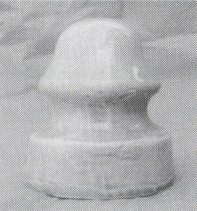
U-240 N-N Pittsburg with
buff-colored glaze finely sprinkled
with
cinnamon-colored specs.
Fred Collier, Jr. (NIA #2933) is always coming up with interesting porcelain
insulators we have not seen before (remember the U-500A shown in the Value
Guide?). Fred reported the next insulator several years ago, and it has taken me
awhile to discover something more about it. The white-glazed insulator is 2-3/8
inches in diameter and 3-1/4 inches tall. The pinhole is slotted all the way up
and there is an enlarged area at the top of the pinhole. On the top of the
insulator is the marking, PAT. APD FOR. I saw this insulator illustrated in a
Pass & Seymour advertisement Bob Stahr found in the Electrical World
dated
March 4, 1893! It was not shown in either the 1899 or 1900 P&S catalogs, so
Fred's insulator is probably more than 100 years old. Note the rare U-146 in the
advertisement. Fred's insulator is illustrated with a metal pin that has a lug
on one end and a metal clamp to secure the conductor wire on the other end. Evidently the slotted
pinhole would allow the lug to pass through, and, by turning the pin 90 degrees,
the pin would be secured and suspended from the lug. The metal clamp on the
other end had two screws to securely hold the conductor wire. I suspect that a
metal clamp was placed around the wire groove to support the insulator in place.
It could have been used as a mine insulator or on a trolley line to suspend a
low voltage power line.
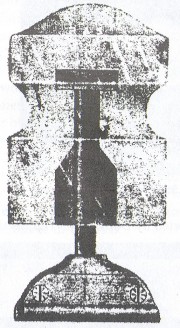
Pass & Seymour white porcelain
insulator shown with metal pin and
clamp
to secure the conductor wire.
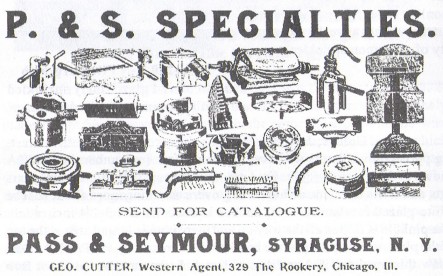
Pass & Seymour advertisement in the Electrical World
dated March 4, 1893.
Daniel van Beers (NIA #4492) tries to stay up-to-date on what is happening in
the world of porcelain insulator manufacturing. He has a lot of contacts with
various companies and he has agreed to let me print some of his findings from
last summer (yes, I'm late with this "news" so hope it is still
current). I will quote Daniel's letter with my comments in [ ]:
"I received some information about Chance [Parkersburg, WV] and
Industrial Ceramics [Lima, NY and Derry, PA]. Seems that the management at
Chance in Parkersburg [manufacturer of pin-types] had attempted to get financing
to buy the plant away from Harvey Hubbell. But they lacked an acceptable
business plan and the plant ended up auctioned off to a "Pacific Rim"
buyer. The plant was, for the most part, dismantled and exported. I do not know
who the "Pacific Rim" buyer is, but I do understand that the plant was
never reassembled, at least as of yet.
"As for Industrial Ceramics, they
have filed for bankruptcy. This was not so much due to an inability to pay
creditors as much as it was in response to an aging plant [Derry, PA] and
nagging disputes that never were resolved. So, they declared themselves
"insolvent", closed the Derry plant, and are very much still in
business in Lima, NY. Their core business remains specialty porcelain and things
like suspension blanks for pole top switches and fused cutout bushings [they
haven't made pin-types since 1987].
"Another interesting item that occurred
recently, Locke [Baltimore, MD] has ceased manufacturing porcelain suspension
insulators [Locke ceased manufacture of pin-types in 1971]. I'm not sure if this
includes line post styles, but Locke does manufacture a line of polymer post
insulators. They are now concentrating on their polymer line manufactured at
their new plant in Virginia Beach, VA.
"Lapp [LeRoy, NY] abruptly exited
the polymer insulator market selling all their equipment to Hubbell/Ohio Brass.
[Lapp ceased manufacture of unipart pintypes in 1957 and multipart pin-types a
few years later.]
"Business at Victor Insulators Inc. [Victor, NY] is quite
good now and they have developed a good export business, too, especially to
Korea and Indonesia. Things look very good at Victor both near and long
term."
It is good news indeed to hear that the old factory at Victor, NY is thriving
after a period of stiff competition. As many of you know, this is the original
site of Fred Locke's porcelain factory which was started in the summer of 1898.
It has changed hands several times with the most recent the result of the
formation of Victor Insulators Inc. in 1984 after a group of employees purchased
the company. The plant continues to be an employee run business. Victor is one
of only two U.S. manufacturers of porcelain pin-type insulators. The other
company is Porcelain Products Co. [Carey, OH].
A special thank you to Phil Gillham in Laredo, TX for his support. Your
generosity, Phil, is very much appreciated!
| 